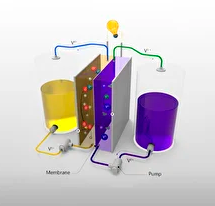 |
Redox flow batteries
In Redox battery energy is stored in charged electrolytes.
Part number:
Supplier:
InEnergy Description
The energy capacity is determined by the volume of the electrolyte, and the power is determined by electrodes area. Flow batteries are scalable and can be easily adapted to customer needs.
more than 20 years of operation
excellent scalability
more than 20,000 charge-discharge cycles
simple and affordable increase in capacity
energy storage capacity and power are independent from each other
Complete discharge is allowed and will not harm the battery
Efficiency - 80%
fast response to load changes, resistance to load drops
fire safety and explosion safety
almost complete absence of self-discharge (<2% per year)
operating temperature range from -30 to 60°C
no harmful emissions during operation
Low specific storage capacity
(20 Wh / l ~ 5 - 10 times lower than
that of Li-ion batteries)
Battery performance (charge and discharge speed) decreases with decreasing temperature, but operation at low temperatures does not reduce battery life
Due to their high storage capacity vanadium redox batteries are used for peak shaving and capacity management in standalone systems, allowing to save expensive diesel fuel and at the same time improving reliability and of power supply to remote consumers.
Redox batteries are also suitable for buffering solar and wind generation. Another application is utility bill management that is a key driver of returns for behind-the-meter energy storage projects.
more than 20 years of operation
excellent scalability
more than 20,000 charge-discharge cycles
simple and affordable increase in capacity
energy storage capacity and power are independent from each other
Complete discharge is allowed and will not harm the battery
Efficiency - 80%
fast response to load changes, resistance to load drops
fire safety and explosion safety
almost complete absence of self-discharge (<2% per year)
operating temperature range from -30 to 60°C
no harmful emissions during operation
Low specific storage capacity
(20 Wh / l ~ 5 - 10 times lower than
that of Li-ion batteries)
Battery performance (charge and discharge speed) decreases with decreasing temperature, but operation at low temperatures does not reduce battery life
Due to their high storage capacity vanadium redox batteries are used for peak shaving and capacity management in standalone systems, allowing to save expensive diesel fuel and at the same time improving reliability and of power supply to remote consumers.
Redox batteries are also suitable for buffering solar and wind generation. Another application is utility bill management that is a key driver of returns for behind-the-meter energy storage projects.